Critically Analyse the Role of Care Worker in Recognising Abuse
VerifiedAdded on 2023/06/13
|11
|3879
|209
Essay
AI Summary
This essay critically examines the role of a care worker in recognising and responding to abuse suffered by vulnerable adults. It begins by defining safeguarding and vulnerability, then explores different types of abuse, focusing on physical abuse and its impact on individuals. The discussion includes indicators of abuse and the importance of care workers' understanding of these signs. Various policies underpinning safeguarding are analysed, emphasizing the care worker's role in implementing these policies effectively. The essay also considers factors that assist or inhibit partnership working in safeguarding vulnerable adults, highlighting the need for strict action against perpetrators and adherence to legal and organizational policies. Desklib provides this assignment solution along with numerous other resources to aid students in their studies.
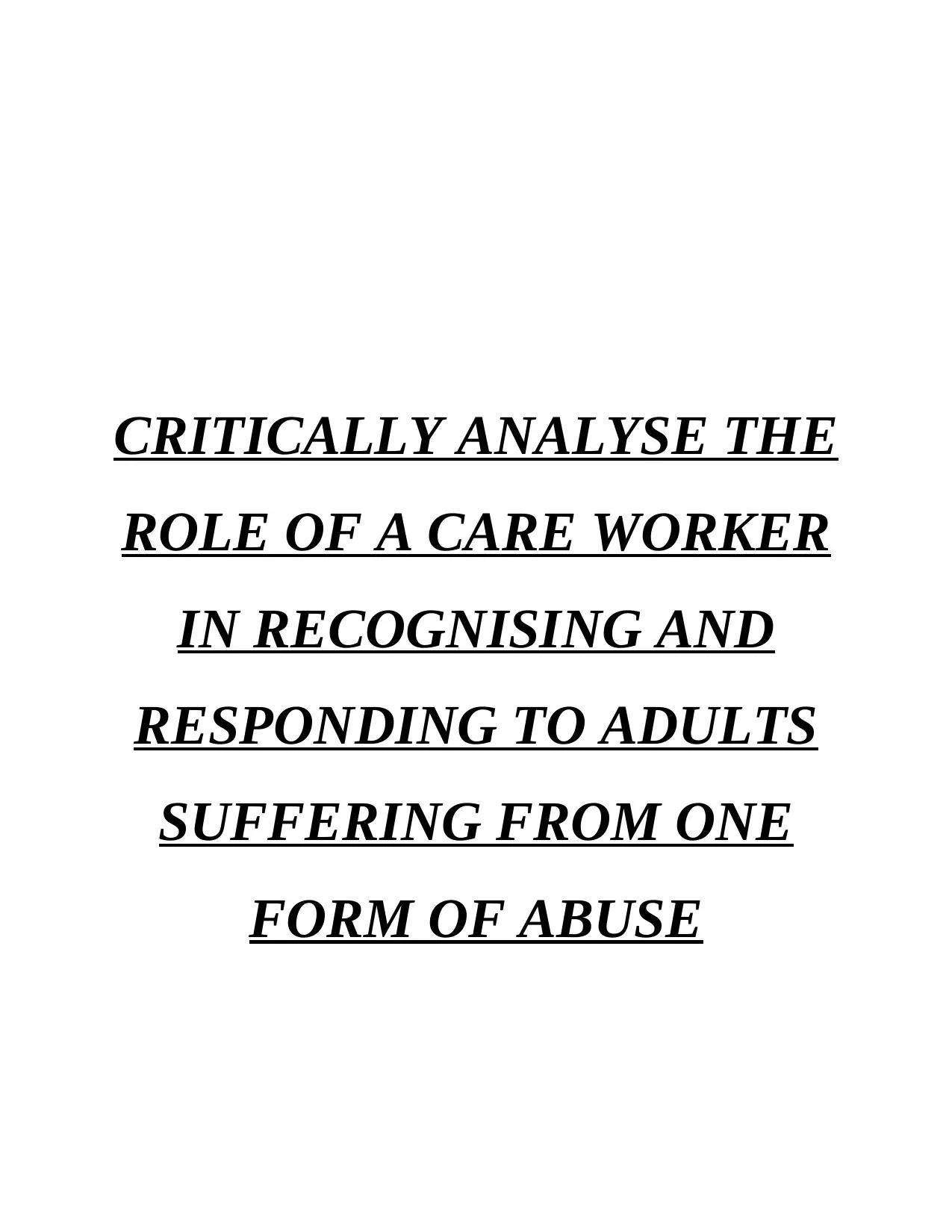
CRITICALLY ANALYSE THE
ROLE OF A CARE WORKER
IN RECOGNISING AND
RESPONDING TO ADULTS
SUFFERING FROM ONE
FORM OF ABUSE
ROLE OF A CARE WORKER
IN RECOGNISING AND
RESPONDING TO ADULTS
SUFFERING FROM ONE
FORM OF ABUSE
Paraphrase This Document
Need a fresh take? Get an instant paraphrase of this document with our AI Paraphraser
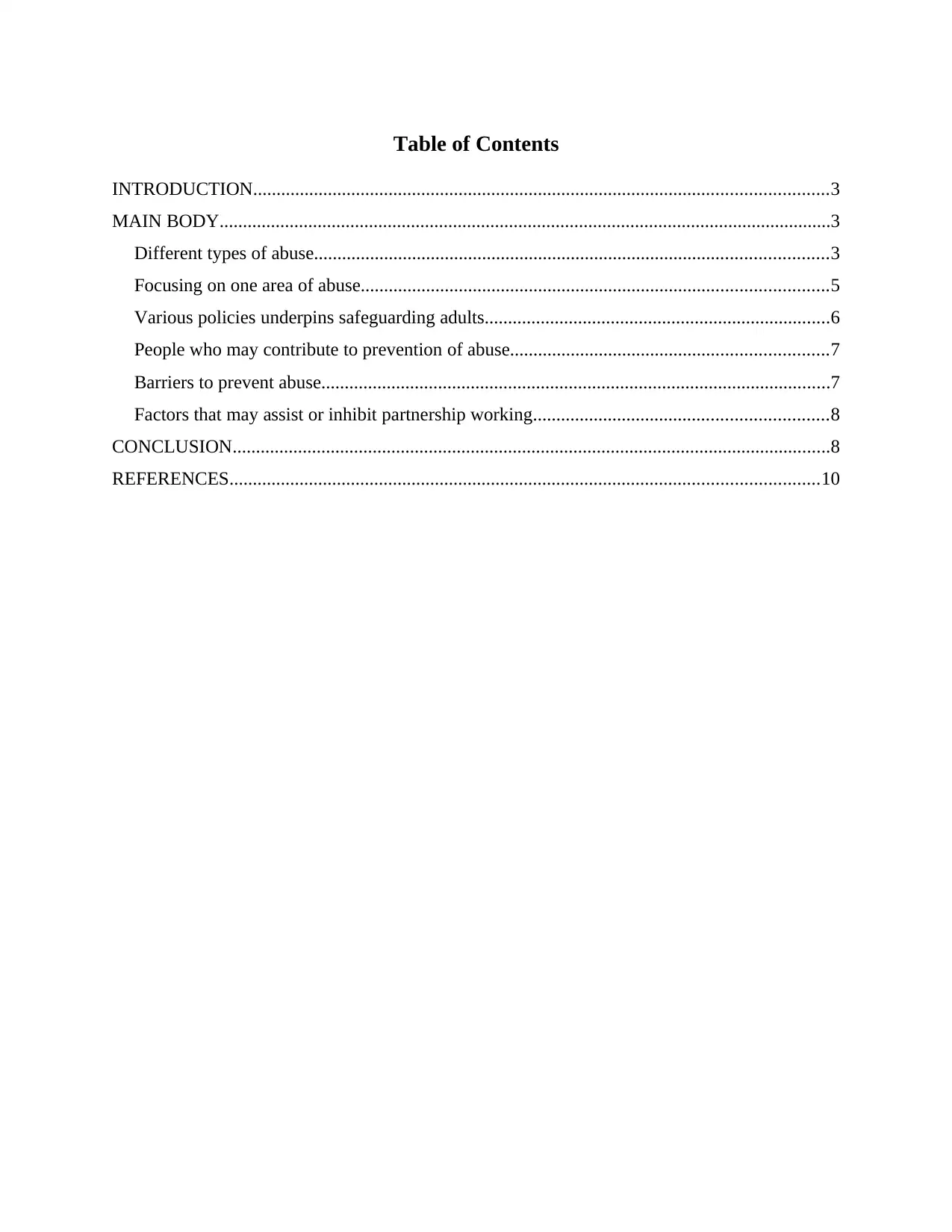
Table of Contents
INTRODUCTION...........................................................................................................................3
MAIN BODY...................................................................................................................................3
Different types of abuse..............................................................................................................3
Focusing on one area of abuse....................................................................................................5
Various policies underpins safeguarding adults..........................................................................6
People who may contribute to prevention of abuse....................................................................7
Barriers to prevent abuse.............................................................................................................7
Factors that may assist or inhibit partnership working...............................................................8
CONCLUSION................................................................................................................................8
REFERENCES..............................................................................................................................10
INTRODUCTION...........................................................................................................................3
MAIN BODY...................................................................................................................................3
Different types of abuse..............................................................................................................3
Focusing on one area of abuse....................................................................................................5
Various policies underpins safeguarding adults..........................................................................6
People who may contribute to prevention of abuse....................................................................7
Barriers to prevent abuse.............................................................................................................7
Factors that may assist or inhibit partnership working...............................................................8
CONCLUSION................................................................................................................................8
REFERENCES..............................................................................................................................10
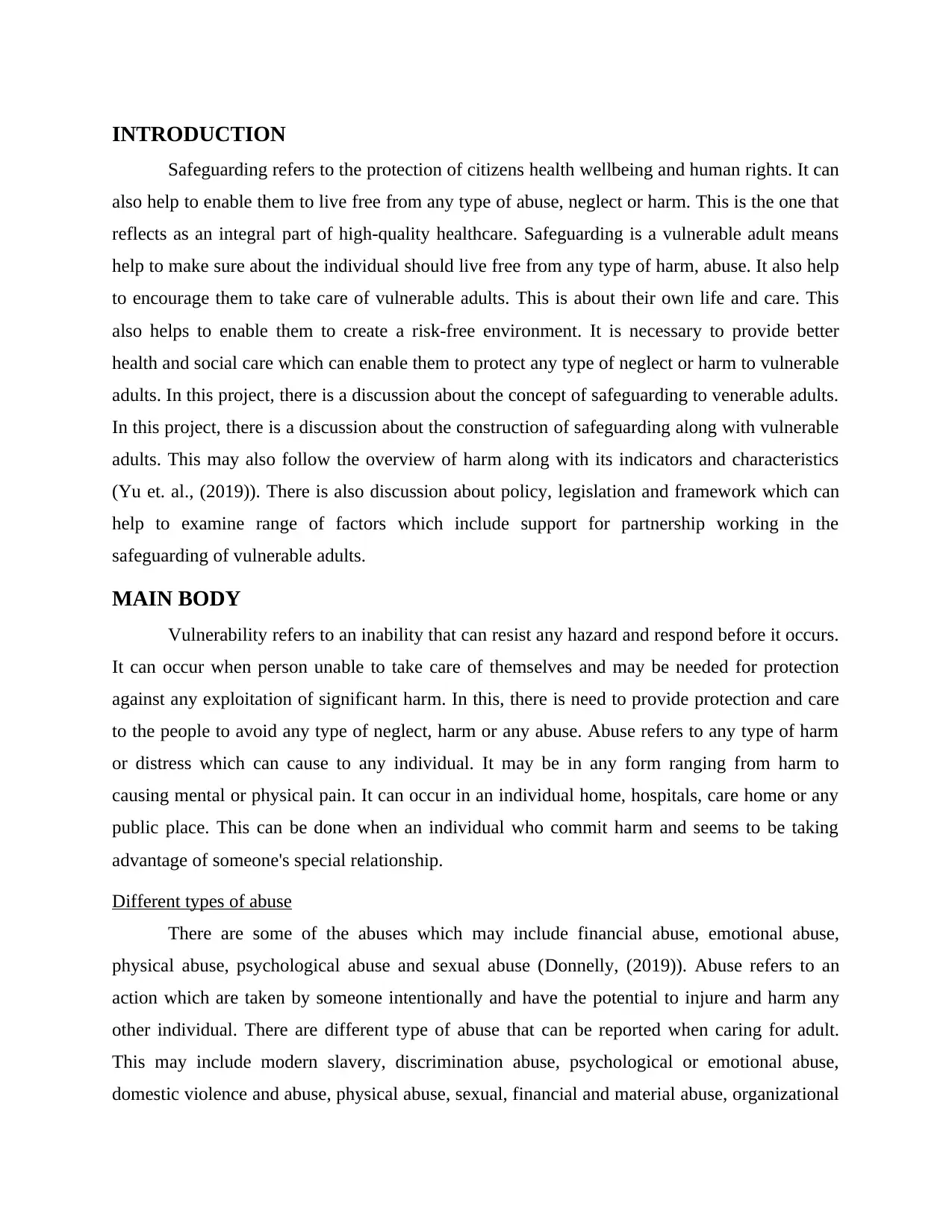
INTRODUCTION
Safeguarding refers to the protection of citizens health wellbeing and human rights. It can
also help to enable them to live free from any type of abuse, neglect or harm. This is the one that
reflects as an integral part of high-quality healthcare. Safeguarding is a vulnerable adult means
help to make sure about the individual should live free from any type of harm, abuse. It also help
to encourage them to take care of vulnerable adults. This is about their own life and care. This
also helps to enable them to create a risk-free environment. It is necessary to provide better
health and social care which can enable them to protect any type of neglect or harm to vulnerable
adults. In this project, there is a discussion about the concept of safeguarding to venerable adults.
In this project, there is a discussion about the construction of safeguarding along with vulnerable
adults. This may also follow the overview of harm along with its indicators and characteristics
(Yu et. al., (2019)). There is also discussion about policy, legislation and framework which can
help to examine range of factors which include support for partnership working in the
safeguarding of vulnerable adults.
MAIN BODY
Vulnerability refers to an inability that can resist any hazard and respond before it occurs.
It can occur when person unable to take care of themselves and may be needed for protection
against any exploitation of significant harm. In this, there is need to provide protection and care
to the people to avoid any type of neglect, harm or any abuse. Abuse refers to any type of harm
or distress which can cause to any individual. It may be in any form ranging from harm to
causing mental or physical pain. It can occur in an individual home, hospitals, care home or any
public place. This can be done when an individual who commit harm and seems to be taking
advantage of someone's special relationship.
Different types of abuse
There are some of the abuses which may include financial abuse, emotional abuse,
physical abuse, psychological abuse and sexual abuse (Donnelly, (2019)). Abuse refers to an
action which are taken by someone intentionally and have the potential to injure and harm any
other individual. There are different type of abuse that can be reported when caring for adult.
This may include modern slavery, discrimination abuse, psychological or emotional abuse,
domestic violence and abuse, physical abuse, sexual, financial and material abuse, organizational
Safeguarding refers to the protection of citizens health wellbeing and human rights. It can
also help to enable them to live free from any type of abuse, neglect or harm. This is the one that
reflects as an integral part of high-quality healthcare. Safeguarding is a vulnerable adult means
help to make sure about the individual should live free from any type of harm, abuse. It also help
to encourage them to take care of vulnerable adults. This is about their own life and care. This
also helps to enable them to create a risk-free environment. It is necessary to provide better
health and social care which can enable them to protect any type of neglect or harm to vulnerable
adults. In this project, there is a discussion about the concept of safeguarding to venerable adults.
In this project, there is a discussion about the construction of safeguarding along with vulnerable
adults. This may also follow the overview of harm along with its indicators and characteristics
(Yu et. al., (2019)). There is also discussion about policy, legislation and framework which can
help to examine range of factors which include support for partnership working in the
safeguarding of vulnerable adults.
MAIN BODY
Vulnerability refers to an inability that can resist any hazard and respond before it occurs.
It can occur when person unable to take care of themselves and may be needed for protection
against any exploitation of significant harm. In this, there is need to provide protection and care
to the people to avoid any type of neglect, harm or any abuse. Abuse refers to any type of harm
or distress which can cause to any individual. It may be in any form ranging from harm to
causing mental or physical pain. It can occur in an individual home, hospitals, care home or any
public place. This can be done when an individual who commit harm and seems to be taking
advantage of someone's special relationship.
Different types of abuse
There are some of the abuses which may include financial abuse, emotional abuse,
physical abuse, psychological abuse and sexual abuse (Donnelly, (2019)). Abuse refers to an
action which are taken by someone intentionally and have the potential to injure and harm any
other individual. There are different type of abuse that can be reported when caring for adult.
This may include modern slavery, discrimination abuse, psychological or emotional abuse,
domestic violence and abuse, physical abuse, sexual, financial and material abuse, organizational
⊘ This is a preview!⊘
Do you want full access?
Subscribe today to unlock all pages.

Trusted by 1+ million students worldwide
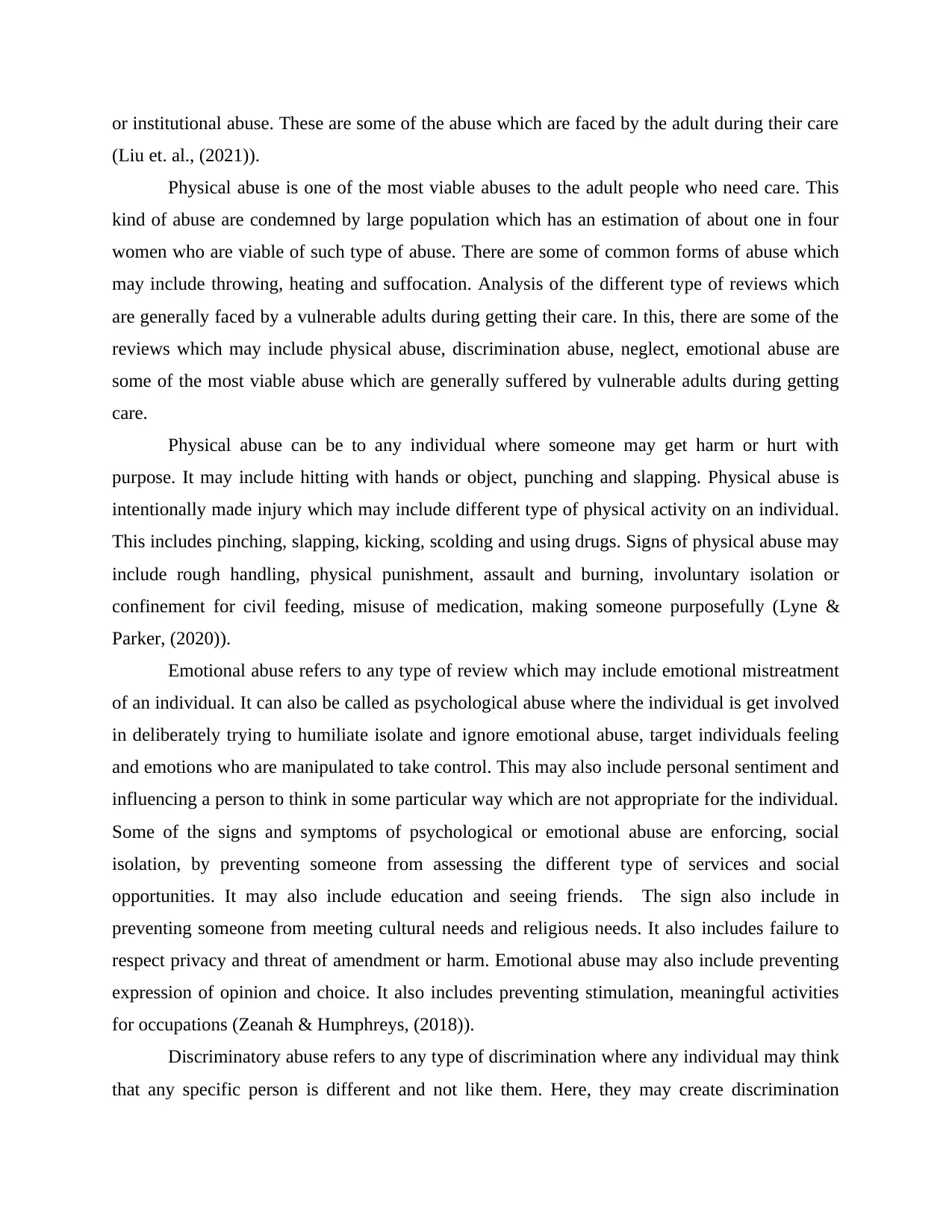
or institutional abuse. These are some of the abuse which are faced by the adult during their care
(Liu et. al., (2021)).
Physical abuse is one of the most viable abuses to the adult people who need care. This
kind of abuse are condemned by large population which has an estimation of about one in four
women who are viable of such type of abuse. There are some of common forms of abuse which
may include throwing, heating and suffocation. Analysis of the different type of reviews which
are generally faced by a vulnerable adults during getting their care. In this, there are some of the
reviews which may include physical abuse, discrimination abuse, neglect, emotional abuse are
some of the most viable abuse which are generally suffered by vulnerable adults during getting
care.
Physical abuse can be to any individual where someone may get harm or hurt with
purpose. It may include hitting with hands or object, punching and slapping. Physical abuse is
intentionally made injury which may include different type of physical activity on an individual.
This includes pinching, slapping, kicking, scolding and using drugs. Signs of physical abuse may
include rough handling, physical punishment, assault and burning, involuntary isolation or
confinement for civil feeding, misuse of medication, making someone purposefully (Lyne &
Parker, (2020)).
Emotional abuse refers to any type of review which may include emotional mistreatment
of an individual. It can also be called as psychological abuse where the individual is get involved
in deliberately trying to humiliate isolate and ignore emotional abuse, target individuals feeling
and emotions who are manipulated to take control. This may also include personal sentiment and
influencing a person to think in some particular way which are not appropriate for the individual.
Some of the signs and symptoms of psychological or emotional abuse are enforcing, social
isolation, by preventing someone from assessing the different type of services and social
opportunities. It may also include education and seeing friends. The sign also include in
preventing someone from meeting cultural needs and religious needs. It also includes failure to
respect privacy and threat of amendment or harm. Emotional abuse may also include preventing
expression of opinion and choice. It also includes preventing stimulation, meaningful activities
for occupations (Zeanah & Humphreys, (2018)).
Discriminatory abuse refers to any type of discrimination where any individual may think
that any specific person is different and not like them. Here, they may create discrimination
(Liu et. al., (2021)).
Physical abuse is one of the most viable abuses to the adult people who need care. This
kind of abuse are condemned by large population which has an estimation of about one in four
women who are viable of such type of abuse. There are some of common forms of abuse which
may include throwing, heating and suffocation. Analysis of the different type of reviews which
are generally faced by a vulnerable adults during getting their care. In this, there are some of the
reviews which may include physical abuse, discrimination abuse, neglect, emotional abuse are
some of the most viable abuse which are generally suffered by vulnerable adults during getting
care.
Physical abuse can be to any individual where someone may get harm or hurt with
purpose. It may include hitting with hands or object, punching and slapping. Physical abuse is
intentionally made injury which may include different type of physical activity on an individual.
This includes pinching, slapping, kicking, scolding and using drugs. Signs of physical abuse may
include rough handling, physical punishment, assault and burning, involuntary isolation or
confinement for civil feeding, misuse of medication, making someone purposefully (Lyne &
Parker, (2020)).
Emotional abuse refers to any type of review which may include emotional mistreatment
of an individual. It can also be called as psychological abuse where the individual is get involved
in deliberately trying to humiliate isolate and ignore emotional abuse, target individuals feeling
and emotions who are manipulated to take control. This may also include personal sentiment and
influencing a person to think in some particular way which are not appropriate for the individual.
Some of the signs and symptoms of psychological or emotional abuse are enforcing, social
isolation, by preventing someone from assessing the different type of services and social
opportunities. It may also include education and seeing friends. The sign also include in
preventing someone from meeting cultural needs and religious needs. It also includes failure to
respect privacy and threat of amendment or harm. Emotional abuse may also include preventing
expression of opinion and choice. It also includes preventing stimulation, meaningful activities
for occupations (Zeanah & Humphreys, (2018)).
Discriminatory abuse refers to any type of discrimination where any individual may think
that any specific person is different and not like them. Here, they may create discrimination
Paraphrase This Document
Need a fresh take? Get an instant paraphrase of this document with our AI Paraphraser
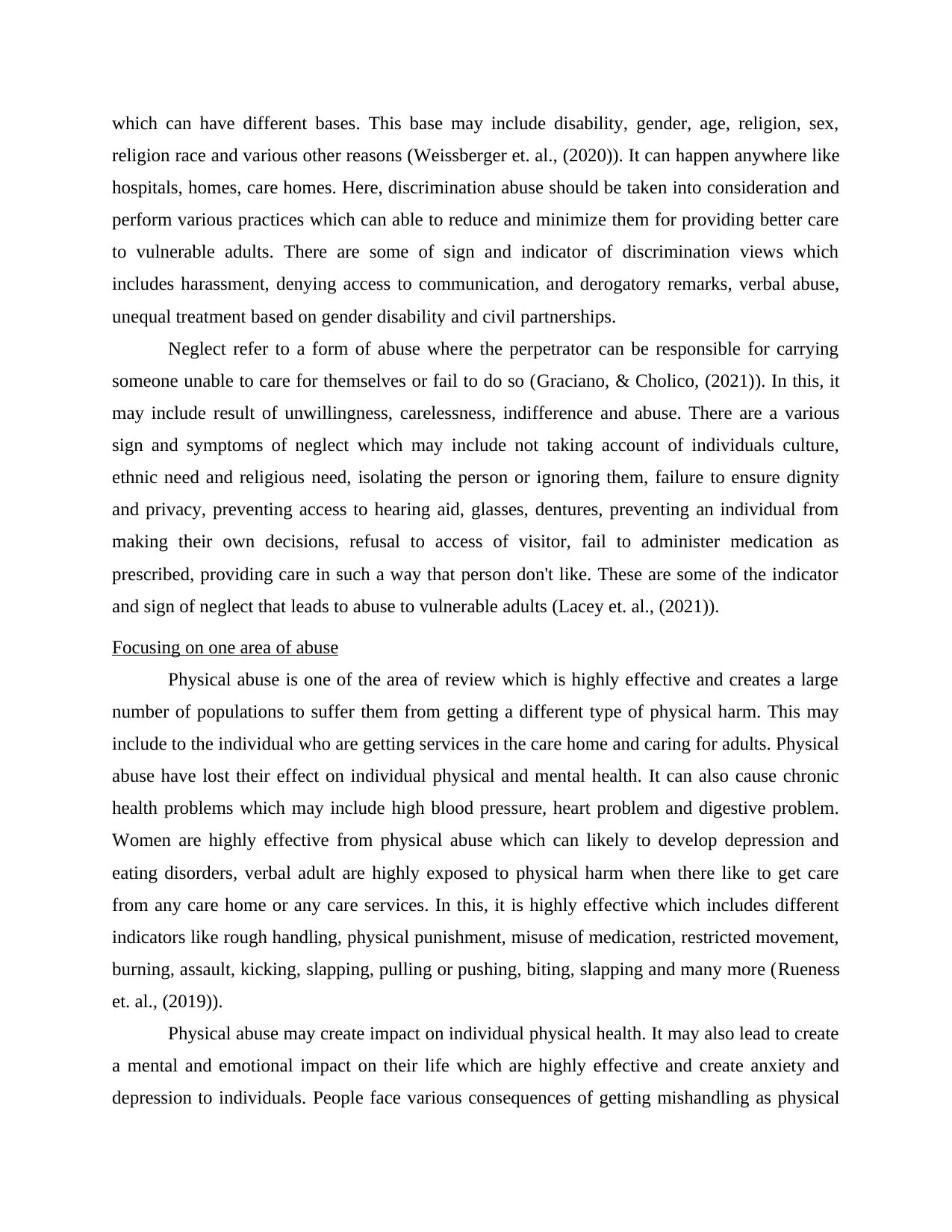
which can have different bases. This base may include disability, gender, age, religion, sex,
religion race and various other reasons (Weissberger et. al., (2020)). It can happen anywhere like
hospitals, homes, care homes. Here, discrimination abuse should be taken into consideration and
perform various practices which can able to reduce and minimize them for providing better care
to vulnerable adults. There are some of sign and indicator of discrimination views which
includes harassment, denying access to communication, and derogatory remarks, verbal abuse,
unequal treatment based on gender disability and civil partnerships.
Neglect refer to a form of abuse where the perpetrator can be responsible for carrying
someone unable to care for themselves or fail to do so (Graciano, & Cholico, (2021)). In this, it
may include result of unwillingness, carelessness, indifference and abuse. There are a various
sign and symptoms of neglect which may include not taking account of individuals culture,
ethnic need and religious need, isolating the person or ignoring them, failure to ensure dignity
and privacy, preventing access to hearing aid, glasses, dentures, preventing an individual from
making their own decisions, refusal to access of visitor, fail to administer medication as
prescribed, providing care in such a way that person don't like. These are some of the indicator
and sign of neglect that leads to abuse to vulnerable adults (Lacey et. al., (2021)).
Focusing on one area of abuse
Physical abuse is one of the area of review which is highly effective and creates a large
number of populations to suffer them from getting a different type of physical harm. This may
include to the individual who are getting services in the care home and caring for adults. Physical
abuse have lost their effect on individual physical and mental health. It can also cause chronic
health problems which may include high blood pressure, heart problem and digestive problem.
Women are highly effective from physical abuse which can likely to develop depression and
eating disorders, verbal adult are highly exposed to physical harm when there like to get care
from any care home or any care services. In this, it is highly effective which includes different
indicators like rough handling, physical punishment, misuse of medication, restricted movement,
burning, assault, kicking, slapping, pulling or pushing, biting, slapping and many more (Rueness
et. al., (2019)).
Physical abuse may create impact on individual physical health. It may also lead to create
a mental and emotional impact on their life which are highly effective and create anxiety and
depression to individuals. People face various consequences of getting mishandling as physical
religion race and various other reasons (Weissberger et. al., (2020)). It can happen anywhere like
hospitals, homes, care homes. Here, discrimination abuse should be taken into consideration and
perform various practices which can able to reduce and minimize them for providing better care
to vulnerable adults. There are some of sign and indicator of discrimination views which
includes harassment, denying access to communication, and derogatory remarks, verbal abuse,
unequal treatment based on gender disability and civil partnerships.
Neglect refer to a form of abuse where the perpetrator can be responsible for carrying
someone unable to care for themselves or fail to do so (Graciano, & Cholico, (2021)). In this, it
may include result of unwillingness, carelessness, indifference and abuse. There are a various
sign and symptoms of neglect which may include not taking account of individuals culture,
ethnic need and religious need, isolating the person or ignoring them, failure to ensure dignity
and privacy, preventing access to hearing aid, glasses, dentures, preventing an individual from
making their own decisions, refusal to access of visitor, fail to administer medication as
prescribed, providing care in such a way that person don't like. These are some of the indicator
and sign of neglect that leads to abuse to vulnerable adults (Lacey et. al., (2021)).
Focusing on one area of abuse
Physical abuse is one of the area of review which is highly effective and creates a large
number of populations to suffer them from getting a different type of physical harm. This may
include to the individual who are getting services in the care home and caring for adults. Physical
abuse have lost their effect on individual physical and mental health. It can also cause chronic
health problems which may include high blood pressure, heart problem and digestive problem.
Women are highly effective from physical abuse which can likely to develop depression and
eating disorders, verbal adult are highly exposed to physical harm when there like to get care
from any care home or any care services. In this, it is highly effective which includes different
indicators like rough handling, physical punishment, misuse of medication, restricted movement,
burning, assault, kicking, slapping, pulling or pushing, biting, slapping and many more (Rueness
et. al., (2019)).
Physical abuse may create impact on individual physical health. It may also lead to create
a mental and emotional impact on their life which are highly effective and create anxiety and
depression to individuals. People face various consequences of getting mishandling as physical
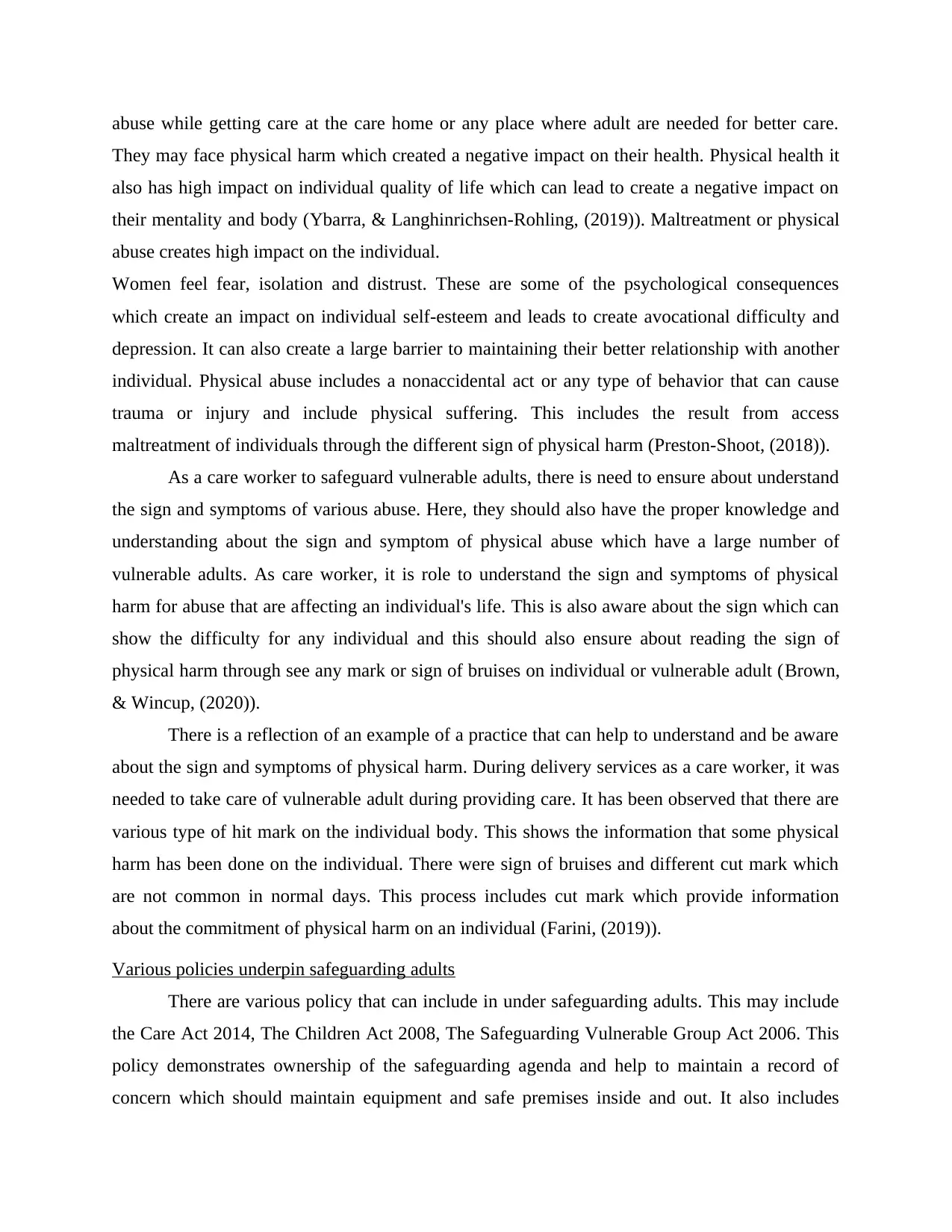
abuse while getting care at the care home or any place where adult are needed for better care.
They may face physical harm which created a negative impact on their health. Physical health it
also has high impact on individual quality of life which can lead to create a negative impact on
their mentality and body (Ybarra, & Langhinrichsen‐Rohling, (2019)). Maltreatment or physical
abuse creates high impact on the individual.
Women feel fear, isolation and distrust. These are some of the psychological consequences
which create an impact on individual self-esteem and leads to create avocational difficulty and
depression. It can also create a large barrier to maintaining their better relationship with another
individual. Physical abuse includes a nonaccidental act or any type of behavior that can cause
trauma or injury and include physical suffering. This includes the result from access
maltreatment of individuals through the different sign of physical harm (Preston-Shoot, (2018)).
As a care worker to safeguard vulnerable adults, there is need to ensure about understand
the sign and symptoms of various abuse. Here, they should also have the proper knowledge and
understanding about the sign and symptom of physical abuse which have a large number of
vulnerable adults. As care worker, it is role to understand the sign and symptoms of physical
harm for abuse that are affecting an individual's life. This is also aware about the sign which can
show the difficulty for any individual and this should also ensure about reading the sign of
physical harm through see any mark or sign of bruises on individual or vulnerable adult (Brown,
& Wincup, (2020)).
There is a reflection of an example of a practice that can help to understand and be aware
about the sign and symptoms of physical harm. During delivery services as a care worker, it was
needed to take care of vulnerable adult during providing care. It has been observed that there are
various type of hit mark on the individual body. This shows the information that some physical
harm has been done on the individual. There were sign of bruises and different cut mark which
are not common in normal days. This process includes cut mark which provide information
about the commitment of physical harm on an individual (Farini, (2019)).
Various policies underpin safeguarding adults
There are various policy that can include in under safeguarding adults. This may include
the Care Act 2014, The Children Act 2008, The Safeguarding Vulnerable Group Act 2006. This
policy demonstrates ownership of the safeguarding agenda and help to maintain a record of
concern which should maintain equipment and safe premises inside and out. It also includes
They may face physical harm which created a negative impact on their health. Physical health it
also has high impact on individual quality of life which can lead to create a negative impact on
their mentality and body (Ybarra, & Langhinrichsen‐Rohling, (2019)). Maltreatment or physical
abuse creates high impact on the individual.
Women feel fear, isolation and distrust. These are some of the psychological consequences
which create an impact on individual self-esteem and leads to create avocational difficulty and
depression. It can also create a large barrier to maintaining their better relationship with another
individual. Physical abuse includes a nonaccidental act or any type of behavior that can cause
trauma or injury and include physical suffering. This includes the result from access
maltreatment of individuals through the different sign of physical harm (Preston-Shoot, (2018)).
As a care worker to safeguard vulnerable adults, there is need to ensure about understand
the sign and symptoms of various abuse. Here, they should also have the proper knowledge and
understanding about the sign and symptom of physical abuse which have a large number of
vulnerable adults. As care worker, it is role to understand the sign and symptoms of physical
harm for abuse that are affecting an individual's life. This is also aware about the sign which can
show the difficulty for any individual and this should also ensure about reading the sign of
physical harm through see any mark or sign of bruises on individual or vulnerable adult (Brown,
& Wincup, (2020)).
There is a reflection of an example of a practice that can help to understand and be aware
about the sign and symptoms of physical harm. During delivery services as a care worker, it was
needed to take care of vulnerable adult during providing care. It has been observed that there are
various type of hit mark on the individual body. This shows the information that some physical
harm has been done on the individual. There were sign of bruises and different cut mark which
are not common in normal days. This process includes cut mark which provide information
about the commitment of physical harm on an individual (Farini, (2019)).
Various policies underpin safeguarding adults
There are various policy that can include in under safeguarding adults. This may include
the Care Act 2014, The Children Act 2008, The Safeguarding Vulnerable Group Act 2006. This
policy demonstrates ownership of the safeguarding agenda and help to maintain a record of
concern which should maintain equipment and safe premises inside and out. It also includes
⊘ This is a preview!⊘
Do you want full access?
Subscribe today to unlock all pages.

Trusted by 1+ million students worldwide
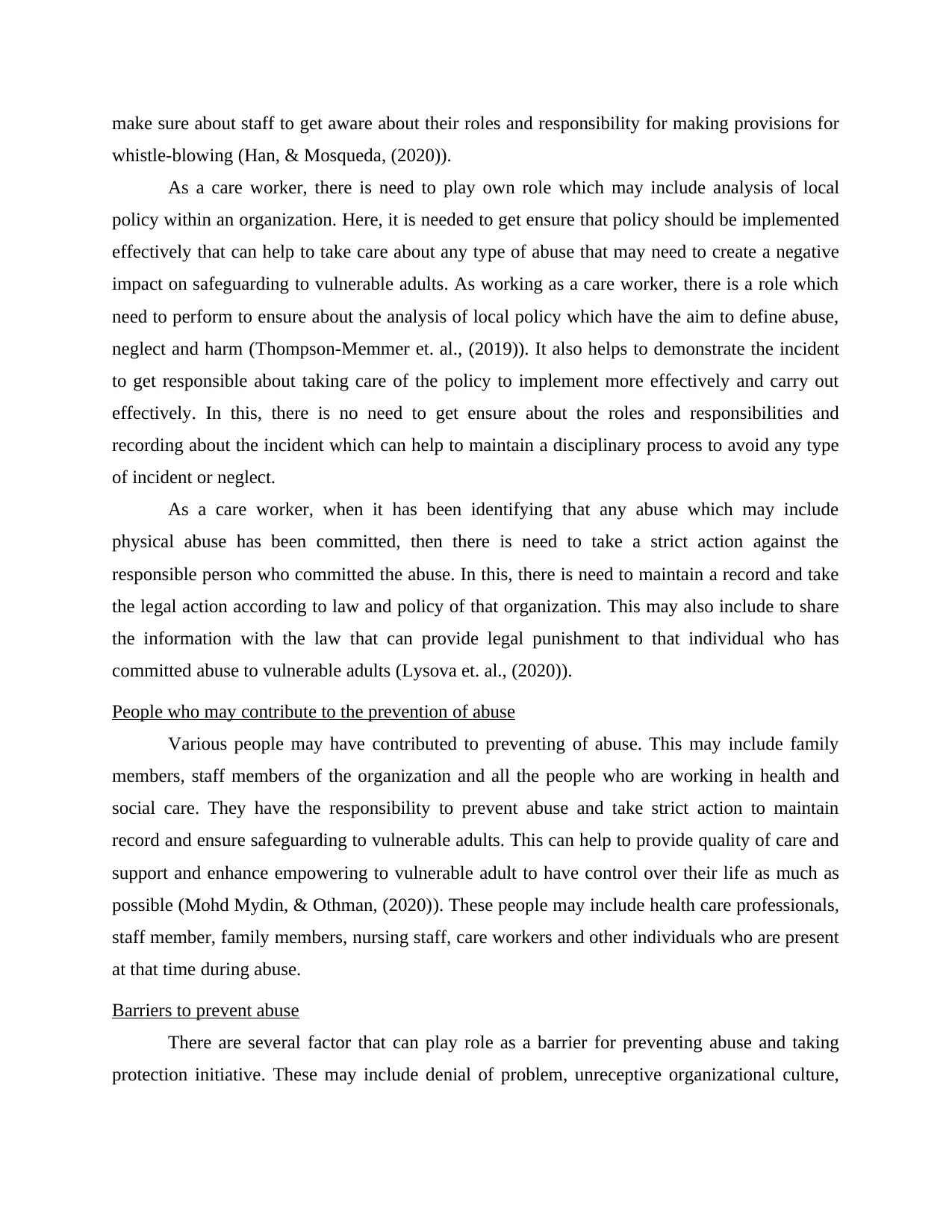
make sure about staff to get aware about their roles and responsibility for making provisions for
whistle-blowing (Han, & Mosqueda, (2020)).
As a care worker, there is need to play own role which may include analysis of local
policy within an organization. Here, it is needed to get ensure that policy should be implemented
effectively that can help to take care about any type of abuse that may need to create a negative
impact on safeguarding to vulnerable adults. As working as a care worker, there is a role which
need to perform to ensure about the analysis of local policy which have the aim to define abuse,
neglect and harm (Thompson-Memmer et. al., (2019)). It also helps to demonstrate the incident
to get responsible about taking care of the policy to implement more effectively and carry out
effectively. In this, there is no need to get ensure about the roles and responsibilities and
recording about the incident which can help to maintain a disciplinary process to avoid any type
of incident or neglect.
As a care worker, when it has been identifying that any abuse which may include
physical abuse has been committed, then there is need to take a strict action against the
responsible person who committed the abuse. In this, there is need to maintain a record and take
the legal action according to law and policy of that organization. This may also include to share
the information with the law that can provide legal punishment to that individual who has
committed abuse to vulnerable adults (Lysova et. al., (2020)).
People who may contribute to the prevention of abuse
Various people may have contributed to preventing of abuse. This may include family
members, staff members of the organization and all the people who are working in health and
social care. They have the responsibility to prevent abuse and take strict action to maintain
record and ensure safeguarding to vulnerable adults. This can help to provide quality of care and
support and enhance empowering to vulnerable adult to have control over their life as much as
possible (Mohd Mydin, & Othman, (2020)). These people may include health care professionals,
staff member, family members, nursing staff, care workers and other individuals who are present
at that time during abuse.
Barriers to prevent abuse
There are several factor that can play role as a barrier for preventing abuse and taking
protection initiative. These may include denial of problem, unreceptive organizational culture,
whistle-blowing (Han, & Mosqueda, (2020)).
As a care worker, there is need to play own role which may include analysis of local
policy within an organization. Here, it is needed to get ensure that policy should be implemented
effectively that can help to take care about any type of abuse that may need to create a negative
impact on safeguarding to vulnerable adults. As working as a care worker, there is a role which
need to perform to ensure about the analysis of local policy which have the aim to define abuse,
neglect and harm (Thompson-Memmer et. al., (2019)). It also helps to demonstrate the incident
to get responsible about taking care of the policy to implement more effectively and carry out
effectively. In this, there is no need to get ensure about the roles and responsibilities and
recording about the incident which can help to maintain a disciplinary process to avoid any type
of incident or neglect.
As a care worker, when it has been identifying that any abuse which may include
physical abuse has been committed, then there is need to take a strict action against the
responsible person who committed the abuse. In this, there is need to maintain a record and take
the legal action according to law and policy of that organization. This may also include to share
the information with the law that can provide legal punishment to that individual who has
committed abuse to vulnerable adults (Lysova et. al., (2020)).
People who may contribute to the prevention of abuse
Various people may have contributed to preventing of abuse. This may include family
members, staff members of the organization and all the people who are working in health and
social care. They have the responsibility to prevent abuse and take strict action to maintain
record and ensure safeguarding to vulnerable adults. This can help to provide quality of care and
support and enhance empowering to vulnerable adult to have control over their life as much as
possible (Mohd Mydin, & Othman, (2020)). These people may include health care professionals,
staff member, family members, nursing staff, care workers and other individuals who are present
at that time during abuse.
Barriers to prevent abuse
There are several factor that can play role as a barrier for preventing abuse and taking
protection initiative. These may include denial of problem, unreceptive organizational culture,
Paraphrase This Document
Need a fresh take? Get an instant paraphrase of this document with our AI Paraphraser
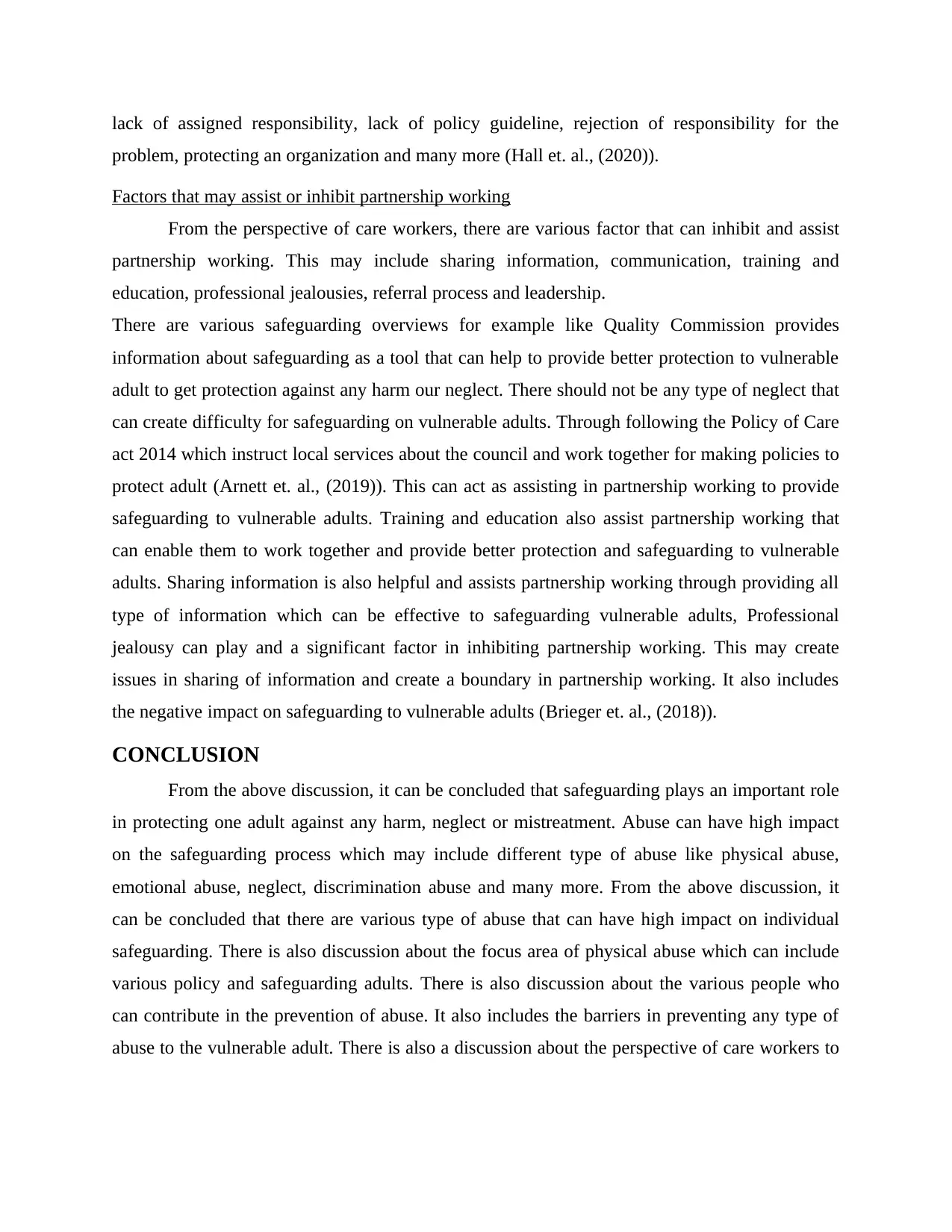
lack of assigned responsibility, lack of policy guideline, rejection of responsibility for the
problem, protecting an organization and many more (Hall et. al., (2020)).
Factors that may assist or inhibit partnership working
From the perspective of care workers, there are various factor that can inhibit and assist
partnership working. This may include sharing information, communication, training and
education, professional jealousies, referral process and leadership.
There are various safeguarding overviews for example like Quality Commission provides
information about safeguarding as a tool that can help to provide better protection to vulnerable
adult to get protection against any harm our neglect. There should not be any type of neglect that
can create difficulty for safeguarding on vulnerable adults. Through following the Policy of Care
act 2014 which instruct local services about the council and work together for making policies to
protect adult (Arnett et. al., (2019)). This can act as assisting in partnership working to provide
safeguarding to vulnerable adults. Training and education also assist partnership working that
can enable them to work together and provide better protection and safeguarding to vulnerable
adults. Sharing information is also helpful and assists partnership working through providing all
type of information which can be effective to safeguarding vulnerable adults, Professional
jealousy can play and a significant factor in inhibiting partnership working. This may create
issues in sharing of information and create a boundary in partnership working. It also includes
the negative impact on safeguarding to vulnerable adults (Brieger et. al., (2018)).
CONCLUSION
From the above discussion, it can be concluded that safeguarding plays an important role
in protecting one adult against any harm, neglect or mistreatment. Abuse can have high impact
on the safeguarding process which may include different type of abuse like physical abuse,
emotional abuse, neglect, discrimination abuse and many more. From the above discussion, it
can be concluded that there are various type of abuse that can have high impact on individual
safeguarding. There is also discussion about the focus area of physical abuse which can include
various policy and safeguarding adults. There is also discussion about the various people who
can contribute in the prevention of abuse. It also includes the barriers in preventing any type of
abuse to the vulnerable adult. There is also a discussion about the perspective of care workers to
problem, protecting an organization and many more (Hall et. al., (2020)).
Factors that may assist or inhibit partnership working
From the perspective of care workers, there are various factor that can inhibit and assist
partnership working. This may include sharing information, communication, training and
education, professional jealousies, referral process and leadership.
There are various safeguarding overviews for example like Quality Commission provides
information about safeguarding as a tool that can help to provide better protection to vulnerable
adult to get protection against any harm our neglect. There should not be any type of neglect that
can create difficulty for safeguarding on vulnerable adults. Through following the Policy of Care
act 2014 which instruct local services about the council and work together for making policies to
protect adult (Arnett et. al., (2019)). This can act as assisting in partnership working to provide
safeguarding to vulnerable adults. Training and education also assist partnership working that
can enable them to work together and provide better protection and safeguarding to vulnerable
adults. Sharing information is also helpful and assists partnership working through providing all
type of information which can be effective to safeguarding vulnerable adults, Professional
jealousy can play and a significant factor in inhibiting partnership working. This may create
issues in sharing of information and create a boundary in partnership working. It also includes
the negative impact on safeguarding to vulnerable adults (Brieger et. al., (2018)).
CONCLUSION
From the above discussion, it can be concluded that safeguarding plays an important role
in protecting one adult against any harm, neglect or mistreatment. Abuse can have high impact
on the safeguarding process which may include different type of abuse like physical abuse,
emotional abuse, neglect, discrimination abuse and many more. From the above discussion, it
can be concluded that there are various type of abuse that can have high impact on individual
safeguarding. There is also discussion about the focus area of physical abuse which can include
various policy and safeguarding adults. There is also discussion about the various people who
can contribute in the prevention of abuse. It also includes the barriers in preventing any type of
abuse to the vulnerable adult. There is also a discussion about the perspective of care workers to
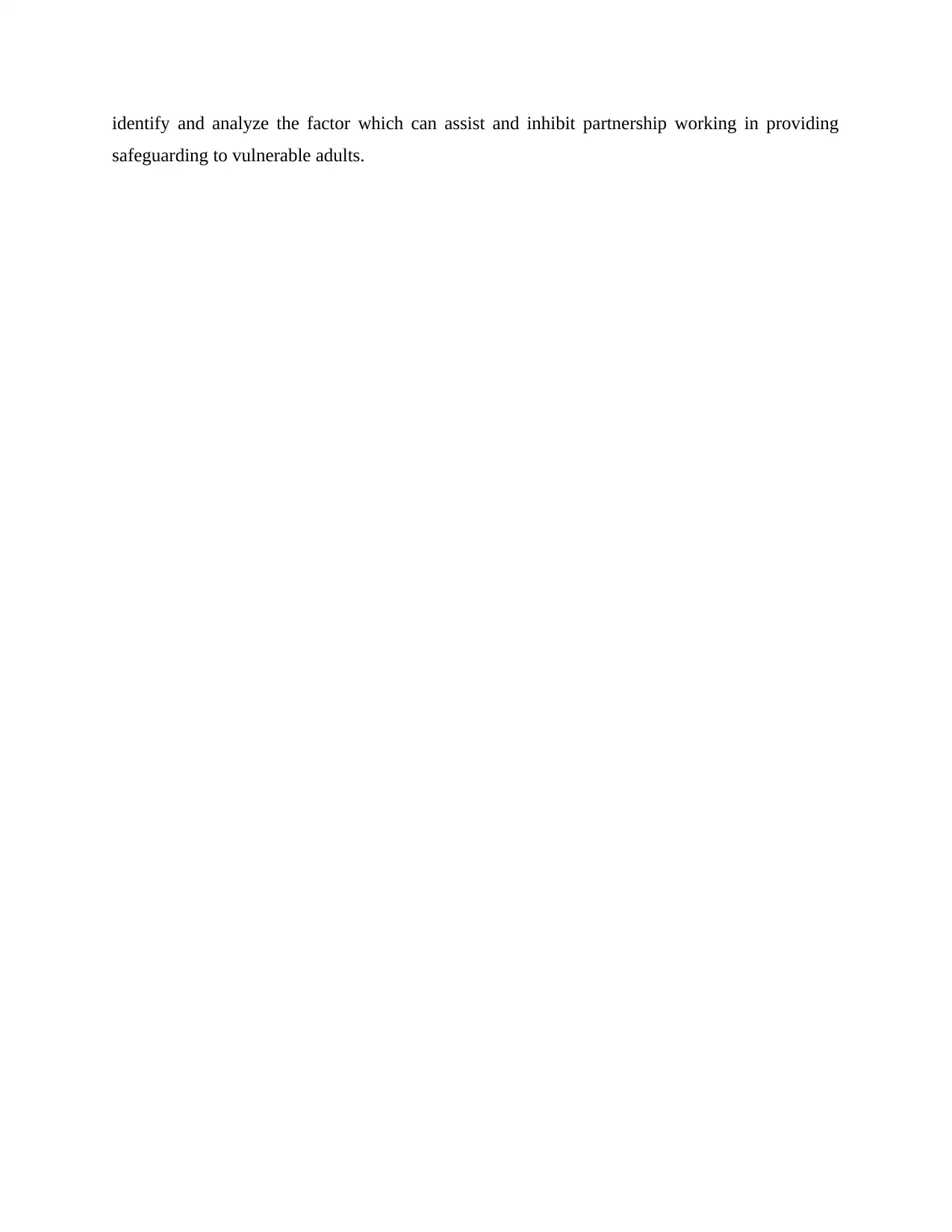
identify and analyze the factor which can assist and inhibit partnership working in providing
safeguarding to vulnerable adults.
safeguarding to vulnerable adults.
⊘ This is a preview!⊘
Do you want full access?
Subscribe today to unlock all pages.

Trusted by 1+ million students worldwide
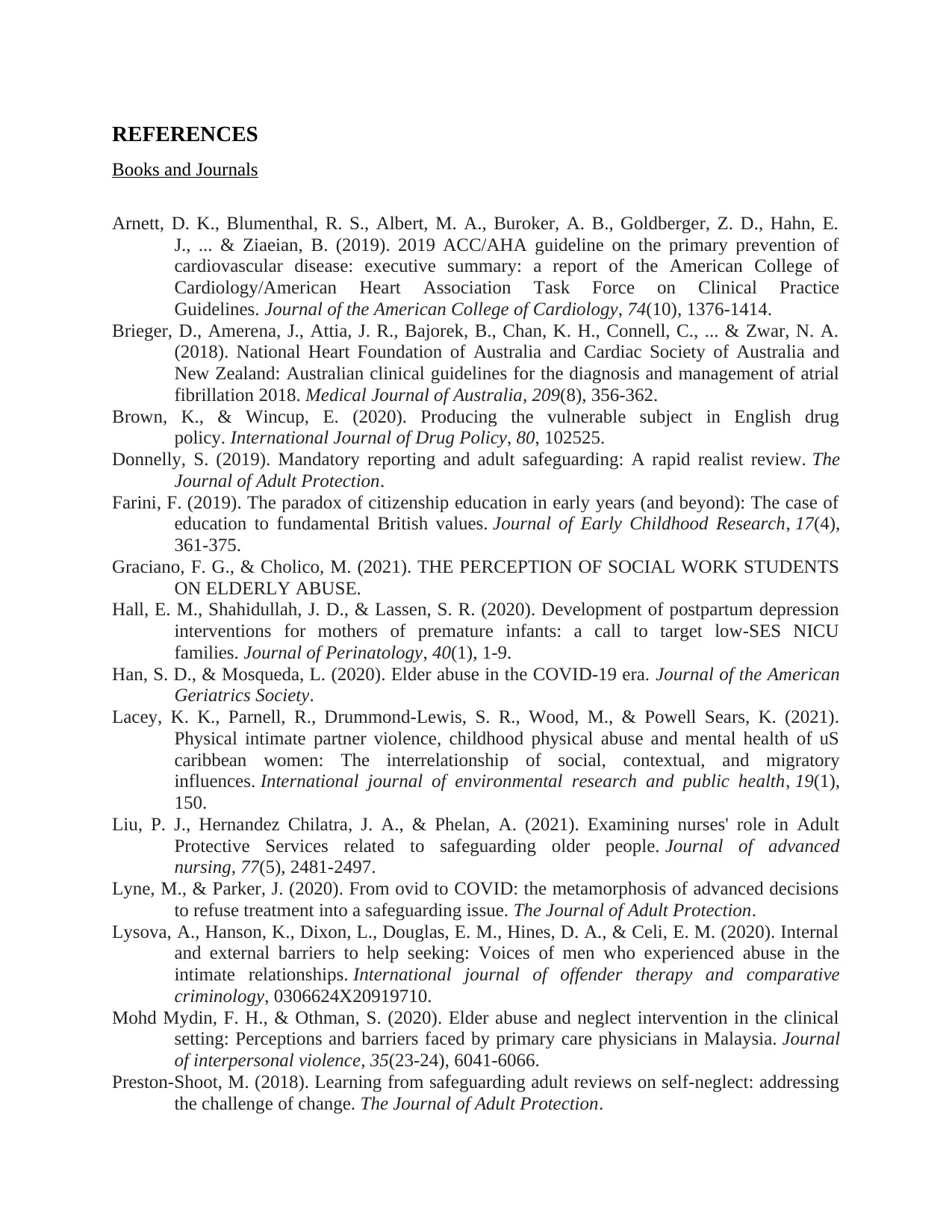
REFERENCES
Books and Journals
Arnett, D. K., Blumenthal, R. S., Albert, M. A., Buroker, A. B., Goldberger, Z. D., Hahn, E.
J., ... & Ziaeian, B. (2019). 2019 ACC/AHA guideline on the primary prevention of
cardiovascular disease: executive summary: a report of the American College of
Cardiology/American Heart Association Task Force on Clinical Practice
Guidelines. Journal of the American College of Cardiology, 74(10), 1376-1414.
Brieger, D., Amerena, J., Attia, J. R., Bajorek, B., Chan, K. H., Connell, C., ... & Zwar, N. A.
(2018). National Heart Foundation of Australia and Cardiac Society of Australia and
New Zealand: Australian clinical guidelines for the diagnosis and management of atrial
fibrillation 2018. Medical Journal of Australia, 209(8), 356-362.
Brown, K., & Wincup, E. (2020). Producing the vulnerable subject in English drug
policy. International Journal of Drug Policy, 80, 102525.
Donnelly, S. (2019). Mandatory reporting and adult safeguarding: A rapid realist review. The
Journal of Adult Protection.
Farini, F. (2019). The paradox of citizenship education in early years (and beyond): The case of
education to fundamental British values. Journal of Early Childhood Research, 17(4),
361-375.
Graciano, F. G., & Cholico, M. (2021). THE PERCEPTION OF SOCIAL WORK STUDENTS
ON ELDERLY ABUSE.
Hall, E. M., Shahidullah, J. D., & Lassen, S. R. (2020). Development of postpartum depression
interventions for mothers of premature infants: a call to target low-SES NICU
families. Journal of Perinatology, 40(1), 1-9.
Han, S. D., & Mosqueda, L. (2020). Elder abuse in the COVID‐19 era. Journal of the American
Geriatrics Society.
Lacey, K. K., Parnell, R., Drummond-Lewis, S. R., Wood, M., & Powell Sears, K. (2021).
Physical intimate partner violence, childhood physical abuse and mental health of uS
caribbean women: The interrelationship of social, contextual, and migratory
influences. International journal of environmental research and public health, 19(1),
150.
Liu, P. J., Hernandez Chilatra, J. A., & Phelan, A. (2021). Examining nurses' role in Adult
Protective Services related to safeguarding older people. Journal of advanced
nursing, 77(5), 2481-2497.
Lyne, M., & Parker, J. (2020). From ovid to COVID: the metamorphosis of advanced decisions
to refuse treatment into a safeguarding issue. The Journal of Adult Protection.
Lysova, A., Hanson, K., Dixon, L., Douglas, E. M., Hines, D. A., & Celi, E. M. (2020). Internal
and external barriers to help seeking: Voices of men who experienced abuse in the
intimate relationships. International journal of offender therapy and comparative
criminology, 0306624X20919710.
Mohd Mydin, F. H., & Othman, S. (2020). Elder abuse and neglect intervention in the clinical
setting: Perceptions and barriers faced by primary care physicians in Malaysia. Journal
of interpersonal violence, 35(23-24), 6041-6066.
Preston-Shoot, M. (2018). Learning from safeguarding adult reviews on self-neglect: addressing
the challenge of change. The Journal of Adult Protection.
Books and Journals
Arnett, D. K., Blumenthal, R. S., Albert, M. A., Buroker, A. B., Goldberger, Z. D., Hahn, E.
J., ... & Ziaeian, B. (2019). 2019 ACC/AHA guideline on the primary prevention of
cardiovascular disease: executive summary: a report of the American College of
Cardiology/American Heart Association Task Force on Clinical Practice
Guidelines. Journal of the American College of Cardiology, 74(10), 1376-1414.
Brieger, D., Amerena, J., Attia, J. R., Bajorek, B., Chan, K. H., Connell, C., ... & Zwar, N. A.
(2018). National Heart Foundation of Australia and Cardiac Society of Australia and
New Zealand: Australian clinical guidelines for the diagnosis and management of atrial
fibrillation 2018. Medical Journal of Australia, 209(8), 356-362.
Brown, K., & Wincup, E. (2020). Producing the vulnerable subject in English drug
policy. International Journal of Drug Policy, 80, 102525.
Donnelly, S. (2019). Mandatory reporting and adult safeguarding: A rapid realist review. The
Journal of Adult Protection.
Farini, F. (2019). The paradox of citizenship education in early years (and beyond): The case of
education to fundamental British values. Journal of Early Childhood Research, 17(4),
361-375.
Graciano, F. G., & Cholico, M. (2021). THE PERCEPTION OF SOCIAL WORK STUDENTS
ON ELDERLY ABUSE.
Hall, E. M., Shahidullah, J. D., & Lassen, S. R. (2020). Development of postpartum depression
interventions for mothers of premature infants: a call to target low-SES NICU
families. Journal of Perinatology, 40(1), 1-9.
Han, S. D., & Mosqueda, L. (2020). Elder abuse in the COVID‐19 era. Journal of the American
Geriatrics Society.
Lacey, K. K., Parnell, R., Drummond-Lewis, S. R., Wood, M., & Powell Sears, K. (2021).
Physical intimate partner violence, childhood physical abuse and mental health of uS
caribbean women: The interrelationship of social, contextual, and migratory
influences. International journal of environmental research and public health, 19(1),
150.
Liu, P. J., Hernandez Chilatra, J. A., & Phelan, A. (2021). Examining nurses' role in Adult
Protective Services related to safeguarding older people. Journal of advanced
nursing, 77(5), 2481-2497.
Lyne, M., & Parker, J. (2020). From ovid to COVID: the metamorphosis of advanced decisions
to refuse treatment into a safeguarding issue. The Journal of Adult Protection.
Lysova, A., Hanson, K., Dixon, L., Douglas, E. M., Hines, D. A., & Celi, E. M. (2020). Internal
and external barriers to help seeking: Voices of men who experienced abuse in the
intimate relationships. International journal of offender therapy and comparative
criminology, 0306624X20919710.
Mohd Mydin, F. H., & Othman, S. (2020). Elder abuse and neglect intervention in the clinical
setting: Perceptions and barriers faced by primary care physicians in Malaysia. Journal
of interpersonal violence, 35(23-24), 6041-6066.
Preston-Shoot, M. (2018). Learning from safeguarding adult reviews on self-neglect: addressing
the challenge of change. The Journal of Adult Protection.
Paraphrase This Document
Need a fresh take? Get an instant paraphrase of this document with our AI Paraphraser
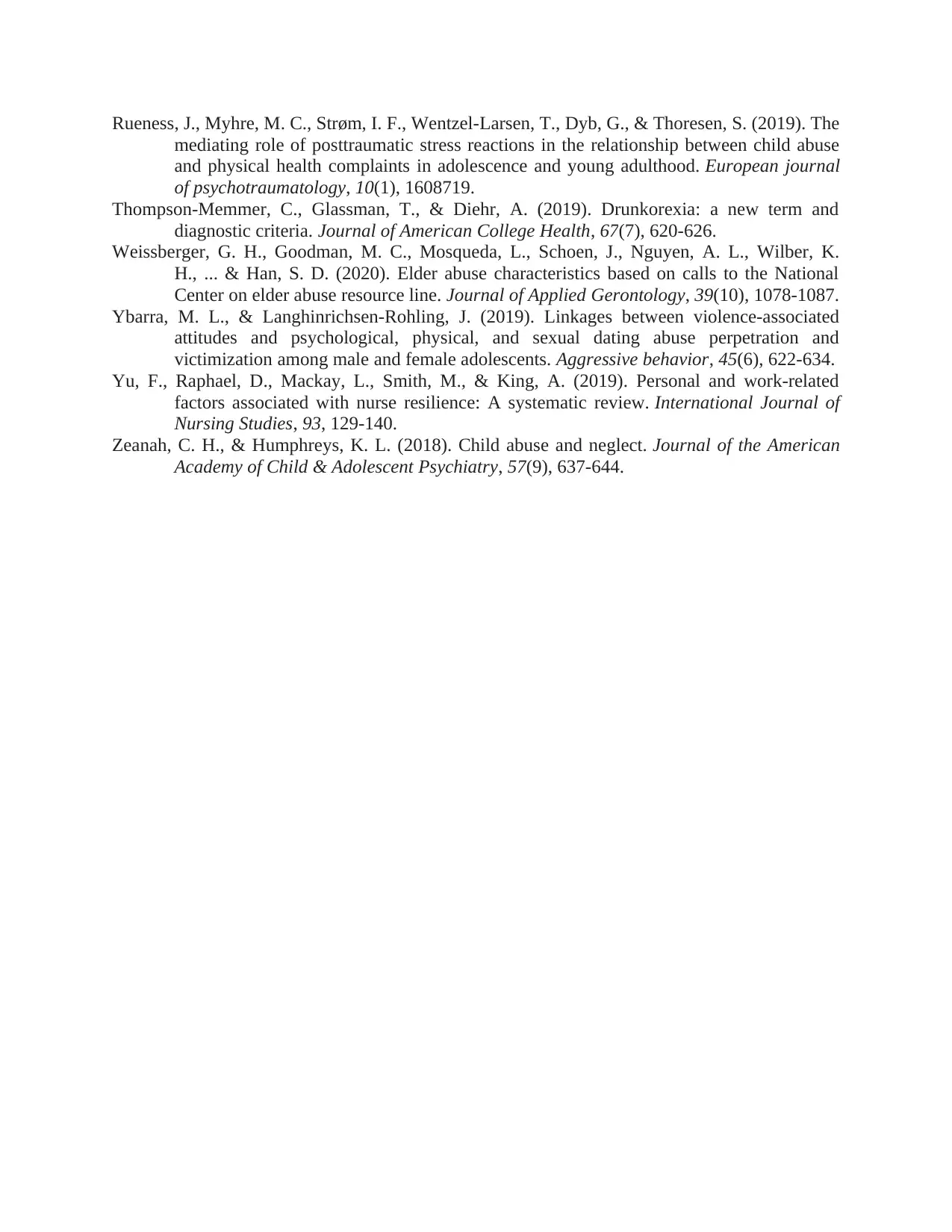
Rueness, J., Myhre, M. C., Strøm, I. F., Wentzel-Larsen, T., Dyb, G., & Thoresen, S. (2019). The
mediating role of posttraumatic stress reactions in the relationship between child abuse
and physical health complaints in adolescence and young adulthood. European journal
of psychotraumatology, 10(1), 1608719.
Thompson-Memmer, C., Glassman, T., & Diehr, A. (2019). Drunkorexia: a new term and
diagnostic criteria. Journal of American College Health, 67(7), 620-626.
Weissberger, G. H., Goodman, M. C., Mosqueda, L., Schoen, J., Nguyen, A. L., Wilber, K.
H., ... & Han, S. D. (2020). Elder abuse characteristics based on calls to the National
Center on elder abuse resource line. Journal of Applied Gerontology, 39(10), 1078-1087.
Ybarra, M. L., & Langhinrichsen‐Rohling, J. (2019). Linkages between violence‐associated
attitudes and psychological, physical, and sexual dating abuse perpetration and
victimization among male and female adolescents. Aggressive behavior, 45(6), 622-634.
Yu, F., Raphael, D., Mackay, L., Smith, M., & King, A. (2019). Personal and work-related
factors associated with nurse resilience: A systematic review. International Journal of
Nursing Studies, 93, 129-140.
Zeanah, C. H., & Humphreys, K. L. (2018). Child abuse and neglect. Journal of the American
Academy of Child & Adolescent Psychiatry, 57(9), 637-644.
mediating role of posttraumatic stress reactions in the relationship between child abuse
and physical health complaints in adolescence and young adulthood. European journal
of psychotraumatology, 10(1), 1608719.
Thompson-Memmer, C., Glassman, T., & Diehr, A. (2019). Drunkorexia: a new term and
diagnostic criteria. Journal of American College Health, 67(7), 620-626.
Weissberger, G. H., Goodman, M. C., Mosqueda, L., Schoen, J., Nguyen, A. L., Wilber, K.
H., ... & Han, S. D. (2020). Elder abuse characteristics based on calls to the National
Center on elder abuse resource line. Journal of Applied Gerontology, 39(10), 1078-1087.
Ybarra, M. L., & Langhinrichsen‐Rohling, J. (2019). Linkages between violence‐associated
attitudes and psychological, physical, and sexual dating abuse perpetration and
victimization among male and female adolescents. Aggressive behavior, 45(6), 622-634.
Yu, F., Raphael, D., Mackay, L., Smith, M., & King, A. (2019). Personal and work-related
factors associated with nurse resilience: A systematic review. International Journal of
Nursing Studies, 93, 129-140.
Zeanah, C. H., & Humphreys, K. L. (2018). Child abuse and neglect. Journal of the American
Academy of Child & Adolescent Psychiatry, 57(9), 637-644.
1 out of 11
Related Documents
Your All-in-One AI-Powered Toolkit for Academic Success.
+13062052269
info@desklib.com
Available 24*7 on WhatsApp / Email
![[object Object]](/_next/static/media/star-bottom.7253800d.svg)
Unlock your academic potential
Copyright © 2020–2025 A2Z Services. All Rights Reserved. Developed and managed by ZUCOL.





